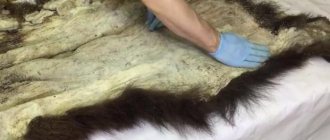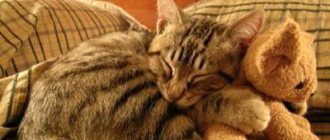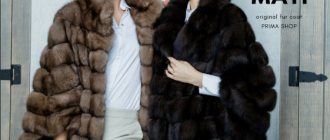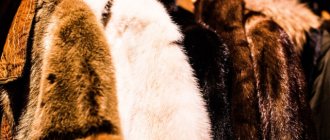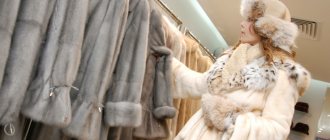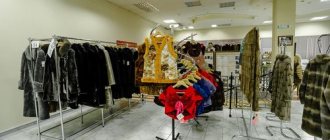History of fur and leather
History of natural fur
Fur is traditionally the oldest material for making clothing. In the entire history of clothing, fur has come the longest way from a simple skin that warmed people in ancient times to modern fashion trends and trends. Primitive people wore it instead of clothing. The use of furs dates back hundreds of thousands of years and has a huge history of its existence. Today, natural fur remains a symbol of social status, wealth, prosperity and luxury. The main thing is that it is necessary to understand what kind of fur we wear, as well as the history of its origin.
In the Middle Ages, natural fur was in enormous demand; it was present on absolutely all costumes of the aristocracy. It was not particularly difficult to obtain the fur of beaver, marten, sable or fox, because many furry animals lived in the vast forests of Europe. There was a very clear relationship between the types of fur and the level of class. Ermine and marten were worn by the upper classes, fox, beaver, otter and hare fur was worn by the middle class of residents. It is known that Isabella of Bavaria did not spare fur to decorate and insulate her outfits. More than 15,000 skins were used for the lining of her clothes.
In the Middle Ages, natural northern squirrel fur also began to be used. The skins were sewn into large plates, which were sold, and tailors cut them like ordinary fabric. Fishing, trade in natural animal fur and leather production were a well-established system. Among the people, natural fur received the nickname “soft gold”, since in some periods of history fur was a means of payment and fully replaced gold.
In Russia, famous for its severe frosts, dense forests and rich in fur-bearing animals, natural furs accounted for a decent share of exports. Russia was the richest country in terms of furs. All of Europe had heard that in Rus' everyone wears furs. Fur, or as it was called “soft junk,” with the development of trade, became one of the main goods that brought considerable income to the treasury. It was at that time that Russian furs (foxes, squirrels, beavers, martens, ermines and sables) began to appear in Europe and were valued no less than jewelry, personifying wealth. In the 18th century, prices for fur increased sharply; a sable fur coat was more expensive than a good house in the city. Fur products were passed down from generation to generation.
The appearance of cars in the 20th century significantly influenced the development of fur fashion. Chic, luxurious and warm clothes were required for walks in convertibles that did not protect from gusts of wind. Long-haired furs - foxes and opossums - came into fashion, followed by bear, wolf, mountain goat and raccoon. The fur of wild monkeys became incredibly popular in the jazzy 20s; it was imitated with the fur of a wild goat. Children's fur coats were also made from goats. At the end of the 60s, embroidered Afghan sheepskin coats, short fur coats made of Mongolian llama and goat came into fashion. In the mid-90s, the Italian fur company Marni produced youth models from goat. It was a relatively inexpensive fur for the financially difficult crisis of the 90s. Karl Lagerfeld presented cashmere coats with goat fur decor in the Fendi winter collection of 1998-1999, and Alexander McQueen presented women's suits with puffed sleeves made of goat fur.
The 21st century is rich in scientific discoveries and high technologies. Every year, the trendy fashion for natural furs changes, and along with it, processing methods, dyeing methods, and production techniques.
Fur has changed beyond recognition - modern technologies make it possible to change the structure and texture of fur, its shape and volume, soften and lighten it, and use new methods of stitching and joining. The latest modifications and treatments of natural fur: laser cutting, degradation, plucking, acid burning, curling, screen dyeing, inlay, embroidery. Blackglama, Fendi and Saga Furs of Scandinavia are leaders in the improvement and renewal of natural fur.
Natural fur has no restrictions on wear - it can be worn with evening, business, casual or sportswear. It is universal for all ages - ladies, gentlemen, and children love it. Fur is reincarnated according to fashion trends and design trends, combined with many materials and textures - in the interior, clothing, hats, shoes, handbags. Fur fashion continues to attract the attention of true connoisseurs of luxury, beauty, comfort and warmth day after day with new trends in high fashion.
Historical facts about fur
The legionary standard bearers of Ancient Rome used the skins of bears and lions to decorate their helmets. This was hardly done to protect against the cold - rather, it caused unnecessary inconvenience to the soldiers during difficult campaigns. But what won’t you do to gain truly divine strength and courage?
The barbarian peoples conquered by the Roman Empire - the Gauls, Germans and Celts - probably dreamed of the same thing. But unlike the inhabitants of the Apennine Peninsula, the inhabitants of Northern and Central Europe dressed in furs for a purely utilitarian purpose - to protect their mortal flesh from frost. At the same time, they did not just throw the skins over their shoulders or heads, they already sewed and cut out outfits from them. This robe was worn with the fur facing out, and many styles resembled the utilitarian Greek tunic. In principle, this outfit could already be called the predecessor of the fur coats familiar to us.
Russian fur had a long history even before it became an integral part of the global fur market. The ancient Russians used furs in their households - it was both warm clothing in cold winters and a soft bed for sleeping. Fur in Ancient Rus' was an important component of economic activity: the skins of sable, marten, beaver and other fur-bearing animals played the role of currency. Fur could be used to pay for any product, education, or church service. Skins were used to collect trade and customs duties, fines, and taxes.
There are known facts in history when valuable furs served as an established form of collecting tribute. For example, in 883, the conqueror Oleg the Prophet imposed a tribute on the “black marten” per house to the Drevlyan nobility. Another important aspect of the existence of fur in Rus' is a gift. Princes and nobles gave valuable furs for “good deeds.” Fur has always been one of the best gifts. On special days and holidays, fur and fur products - fur coats, hats - were presented to members of princely families, priests, noble guests, and ambassadors of foreign states. The value of fur was so great that merchants and nobles passed them on from generation to generation. Fur was one of the most important components of the dowry of rich brides.
In the 10th-11th centuries, fur became an important element of export for Russians to neighboring countries. Kievan Rus began active trade in fur with the countries of the East and Byzantium. Moreover, not only merchants, but also boyars and princes were engaged in the fur trade. Fur was mined in the territories that belong today to Ukraine and Belarus. It was the fur of squirrel, hare, wolf, fox, marten and beaver. Over the next two centuries, merchants opened trade routes to the countries of Western Europe.
For a long time, sable had almost no value among the indigenous people of Siberia and the Far East. The Kamchadals, for example, gave for an iron cauldron as many sables as were included in it.
In the middle of the 11th century, the third daughter Anna, the Kyiv prince Yaroslav the Wise, was married to the French king Henry I. Yaroslav the Wise showed generosity by presenting foreign ambassadors with fur clothes, sent by the king to pick up his bride in Kievan Rus. As a dowry for his daughter, Henry I sent several cartloads of the most valuable fur skins.
In the 12th century, the first set of laws “Russian Truth” was written. It described in detail the rules of hunting for representatives of the nobility, between whom enmity often developed over hunting grounds. For a long time, furs were obtained by hunting, which later became not only an income-generating trade, but also social entertainment. Vladimir Monomakh equated hunting feats with military feats.
In the 13th century, during the heyday of Genghis Khan’s empire, an almost absolute analogue of the current fur coat arose with the fur facing out. The products were suitable for the harsh climate of the Mongolian steppes with their powerful winds in winter. The Mongolian malakhai was comfortable and functional - the lapels protected the neck of the stern warrior from the wind. In severe frost, the Mongols put on one fur coat with the fur inward, and the second on top, with the fur outward.
The main goods of the Middle Ages were martens, beavers, wolves, foxes, squirrels, and hares. Moreover, the trade was mainly in fur brought from the territories that now belong to modern Ukraine and Belarus
In the 15th-16th centuries, it was unprofitable for Russian merchants to trade furs abroad. The Polish authorities, protecting the rights of their merchants, set a condition - the mandatory sale of fur in the territory of the Polish-Lithuanian Commonwealth. This entailed a lot of costs; traders had to pay various duties along the entire route. They
They paid the owners of all the lands through which the merchant route ran for crossing the border and for crossing the bridge. There were some brave souls who resorted to illegally transporting fur, but if discovered, this would result in a huge fine or prison. Also, merchants who ventured on a long journey abroad risked falling into the hands of robbers and coming home completely without earnings.
In the 15th-16th centuries, Russian fur brought from Moscow, thanks to Ukrainian and Polish merchants, gained popularity in Moldova, Wallachia, the Balkan Peninsula, Turkey, Italy, the Netherlands - precisely as “Moscow furs”.
In 1592, the Orthodox church brotherhood from Lvov sent a message to the Russian Tsar Fyodor Ioannovich. The message contained a request for assistance in restoring the burnt Assumption Church. The Lviv brotherhood was granted five forty sables and five forty martens, 50 gold coins for the royal doors of the temple and gilding of the cross, as well as 20 rubles for church servants. As a token of gratitude for the help, the Brotherhood placed a Russian coat of arms in the dome of the church with the text: “The Blessed Tsar and Grand Duke of Moscow Russia Fyodor Ioannovich was the benefactor of the church.” Part of the funds went to the redemption of the mortgaged printing house of the pioneer printer Ivan Fedorov and to the resumption of Cyrillic book printing in Lvov.
In the 16th century in Tobolsk, silver fox was valued more than sable. The price of a black fox brought from another Siberian city to Tobolsk was as much as silver coins could fit into a stocking. At that time, the arctic fox or white fox was also a novelty.
In 1654, the newborn Russian Tsarevich Alexei Alekseevich from Ilimsk was sent a white fox skin as a gift. When Tsar Alexei Mikhailovich instructed the merchants to evaluate the beast, they testified in writing that “they did not know the price,” since they had never seen such a beast.
In 1689, Lviv merchant Yuri Bragnovich bought 488 sables at a fair. In addition, he bought furs from sable backs and bellies, 10 magpie ermines, 20 wolf skins, 6 black wolf skins, 26 white hare skins, 12 wolf belly skins. After paying all the duties and selling all the goods brought, the merchant received a profit of 4296 Polish zlotys, which is an exorbitantly large amount. For comparison, the work of a high-class artisan was valued at 3 to 6 zlotys per week, and for an apprentice - from 6 to 8 groschen.
In the XIV-XVII centuries, Ukrainian merchants who came to Russia for large quantities of furs often became victims of deception. Russian traders, seeing great interest in the arctic fox on the part of visiting merchants, often passed off a hare as him.
In the 17th century, an expedition from the Bering Islands brought a sea otter, which was also called a sea otter or sea beaver. For many years it became one of the riches of Kamchatka, the Commander and Aleutian Islands - after all, sea otter fur was valued more than that of any land animal. Therefore, the Bering Sea was called the Beaver Sea on some maps.
Royal furs of Russia
In the 17th century, the development of Siberia, fabulously rich in valuable species of fur-bearing animals, contributed to the glory of the Russian fur empire. The annexation of the Siberian sable paradise to Russia helped strengthen Moscow’s position in the world fur markets and make “soft belongings” the calling card of commercial Russia, and Russia itself the largest supplier of fur. The Russian state retained this role until the end of the 19th century, when the USA and Canada joined it in the world fur market.
Since the 17th century, the Russian Kingdom was the main source of “soft gold” for Europe and the Ottoman Empire – Turkey. The Ukrainian territories that were part of the Polish-Lithuanian Commonwealth served as a sales point for fur and leather raw materials and a transit corridor for the entry of Russian furs into Western Europe. Ukrainian traders, being active participants in Russian fur trades, strengthened the domestic fur market.
In Russia, the processing of fur raw materials was carried out using ancient methods in small workshops, and tanneries appeared already in the 17th century, and under Catherine II their number reached 30. People have been trying to tame wild animals for centuries. Man tried to find an opportunity to raise animals that could not be domesticated for his needs. in the 18th century in the northern regions of Russia, in the summer they caught fox and arctic fox puppies and raised them in special premises, and slaughtered them in the winter. In the 30s of the 19th century, the Russian Empire was the first in the world to use island fur farming; the first fur farms were on the Commander Islands, where arctic foxes and fur seals were bred. In the Altai Territory, deer were bred. But the real development of fur farming came in the first quarter of the 20th century.
In addition to the export of fur, our country was famous for its fur dynasties. Fur merchants not only provided the fashionable public of Russian cities with furry goods, but also successfully represented Russian furs in Western capitals. Far beyond the borders of Russia, the names of the Sorokoumovskys and Mikhailovs thundered at the beginning of the twentieth century. They had fur salons in all major cities of Russia at that time: St. Petersburg, Kharkov, Warsaw. The heart of fashionable Russia was the Kuznetsky Most district in Moscow. All the best fashion shops and large stores that dress fashionistas in Russia were concentrated here.
All of Russia's "soft gold" was nationalized in 1917, and provided an endless source of currency for the new Soviet government. In this case, the Fur Refrigerator came in handy, which, having already been nationalized, continued its activities, unlike the luxurious fur salons that were alien to the new system. Built five years before the revolution specifically for storing furs, it was an exceptional engineering structure.
The 20th century brought about a revolution and made a breakthrough in establishing fur production. By the beginning of the 20th century, fur-bearing animals were becoming rare in the forests, and a crisis was brewing in the fur trade. It was successfully resolved when industrial breeding of fur-bearing animals began in North America. With the advent of this industry, fur became publicly available. Previously, the cost of fur was determined by the beauty and durability of the skin, and the difficulties of its extraction. Hare fur is fragile and short-lived, but the hare still had to be caught. Therefore, the attitude towards fur was careful. Fur products were repaired, altered, refaced, and in fact completely worn out. In St. Petersburg, at the Alexander Market, now defunct, used fur goods of any price and quality were sold.
In the 20th century, living conditions in European cities improved significantly, became more comfortable, and one of the essential functions of fur, warming, ceased to be so necessary. The value of fur no longer depended so much on how warm it could be.
It became possible to dictate fashion for the use of certain furs, because its “production” could be regulated. Just as only weaving factories had done before, fur manufacturing companies took the definition of fur fashion into their own hands. Many countries that had previously been traditional sellers of commercial furs, by the middle of the twentieth century, were placed in a new position for them, where they could not always cope with fierce competition. Russia was among them. New trends, new market processes for Russia turned out to be very noticeable. Accustomed to its strong position in the fur market, Russia was not ready for the appearance of a huge number of cheap industrially produced furs on the world market. The first fur farms in Russia began to appear before the start of World War II. But the very idea of these farms and the help of specialists in their formation were American and Canadian. Few managed to overcome the crisis of the mid-twentieth century and the crisis of the 90s. But now Russian farms are trying to revive.
In the 20th century, expensive furs remained expensive, but now the price of the product is influenced by the brand or brand of the manufacturer and the fashion trend. The second is less important than the first. A fur coat from Fendi from the latest season's collection, even if it is made of rabbit fur, cannot be compared in price with an unfashionable and unknown marten jacket. A very rich person nowadays can wear cheap fur; the price and prestige of a fur product no longer depend so much on the quality of the fur, but on the attractiveness and cost of the fashion brand.
History of genuine leather
Since ancient times, all tribes and peoples have used natural leather to make clothes and shoes. Almost until the 20th century, in the Far North, residents wore gutted skins of animal paws without processing on their feet. In areas with a warmer climate, animal skins were tanned, as they deteriorated more quickly when they festered.
700-300 thousand years ago, shoes were made from pieces of animal skins, which were processed with sharp stone scrapers. In addition to scraping, the skins were dried, they became “oaky”, they were softened with sticks and stones, kneaded with hands, and lubricated with fat or similar substances. Fatliquoring is a simple and effective method, one of the main stages of tanning natural leather. The Slavs used horse fat for fattening, the Asian nomads used lamb fat, the Japanese used rapeseed oil, the Caucasians used oil, the northerners used egg yolks and liver.
In ancient times, thin and soft natural leather was obtained by shucking - rotten animal excrement was used to make leather. In the East, morocco was tanned using rotten urine and manure; the Indians of South America obtained such thin natural leather by hacking that the surprised Christopher Columbus took it to Spain, which was famous for its morocco - corduan.
In Ancient India in the 4th millennium BC. they tanned morocco by sewing the skin into a wineskin or purse, pouring water and tanning substances inside. In Ancient Persia, shagreen - horse and donkey skin - was tanned in a similar way. This method turned out to be not very economical, so it was replaced by vat tanning of natural leather: vats were filled with water, extracts of coniferous trees, oak bark, and willow were added, and the more acidic and older the solution, the softer the natural leather was. At the same time, the leather was dyed with the addition of: - oak bark - in reddish shades, called red oak;
- walnut shells - brown;
- bearberry, sedge and alder bark - in black colors;
- willows - gray;
- birch and mimosa leaves - yellow.
The Indians of North America kept the skin moist by rubbing it with a mixture of clay and buffalo urine, stretching it, driving wooden nails into the edges of the skin, treating it with fat and marrow, scraping, softening and smoking; the formaldehydes contained in the smoke helped preserve the skin.
Eskimo deer suede was obtained through original processing: the skins were scraped out and rubbed with a mixture of egg yolk, brain and chewed liver (proteins break down enzymes contained in saliva). They kept it for a week to two, rolled up in a bag under the head instead of a pillow.
Animal excrement, ash and lime were used to dehair the skins. Rawhide - hard leather, was obtained from ash, and primitive shoes were sewn from it - postsols, pistons. In Ancient Greece, parchment was obtained by processing rawhide with lime or chalk.
In Central Asia, coating is also widespread. In Russia, natural skin became especially elastic after hair removal with bread jelly: a mixture of salt and fermented flour solution. It was made with a salt solution or in “dead wells”: to ferment the mixture, flour was mixed with water and several dozen buckets of blood were poured out. Residents of the Arabian Peninsula used alum, flour, and egg yolk instead of salt and obtained the finest glove leather - husky. In ancient states they also used leavening: ancient Greek leather - defa, ancient Roman - aluta. In Western Europe, fermentation spread in the first centuries of our era, in Russia - with the reforms of Peter I. Before this, tanning with oak or willow bark was considered native Russian. For tanning and dyeing natural leather, solutions of colored earths and decoctions of the bark of talni-containing plants were used.
Fur in European fashion - 19-20 centuries
In pre-revolutionary Russia, hunting and fur trade were carried out mainly through deception. Fur buyers, through forgery and drugging hunters with alcohol, bought the skins of sables, martens, arctic foxes, and squirrels for next to nothing. Since there were no restrictions on hunting animals, by the beginning of the 20th century many valuable species (sable, fur seal, beaver, marten, etc.) were on the verge of complete extinction.
In the first years of Soviet power, on the personal initiative of V.I. Lenin, the necessary measures were taken aimed at preserving and increasing the number of fur-bearing animals. They established a state monopoly on the purchase and trade of furs, created numerous reserves where hunting periods and the number of animals shot were strictly regulated. The extraction of particularly rare species was prohibited throughout our country. These measures made it possible to quickly restore the number of fur-bearing animals and create favorable conditions for their reproduction.
Fashionable fur outfits, Europe, 1914

